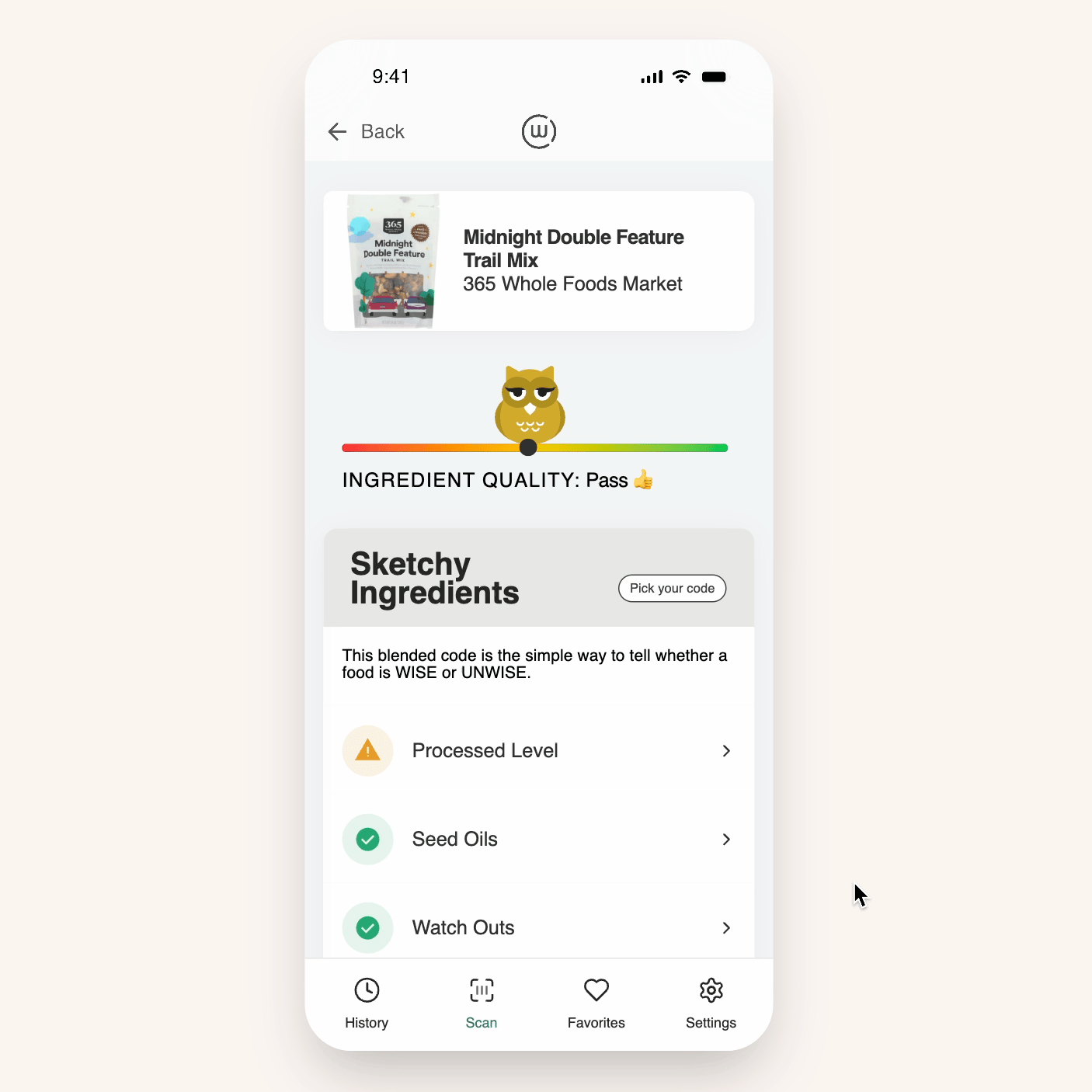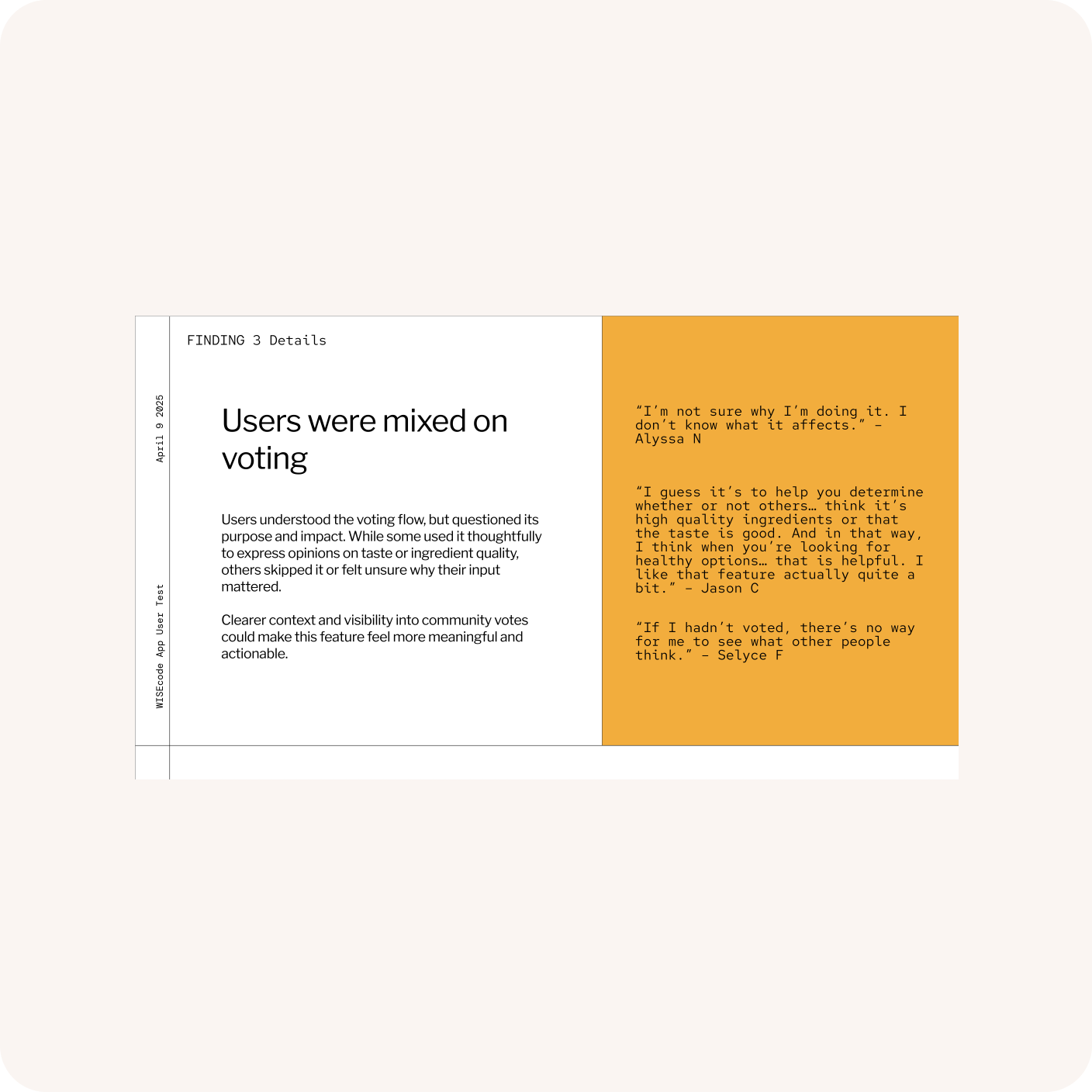Designing the Rudder
Turning a Messy Vision into Product Momentum at WISEcode
WISEcode is an AI-driven personalized health startup with a deep nutrition-science backend. The company already spent years mapping ingredients to nutritional values, and was eager to get a barcode scanner to the market.
When I arrived there was a sense of urgency, frustration, and a history of many false starts.
Here’s how I clarified the mental model so that “codes” worked for consumers, designed the right architecture, and achieved strategy buy-in to get the team to 2026 and beyond.
✔️ Launched MVP in 2 months
✔️ Discovered key product-market fit features through testing and insights
✔️ Created the North Star foundation for an AI-based, personalized nutrition companion
✔️ Set strategy for Marketing+Product Design design system evolution
Role: Principal Designer, acting Head of Design
Timespan: Jan-Aug 2025
Team: Product Manager, CTO, Founder, Flutter Developer

The Mess
In January 2025 WISEcode did not have an in-house designer. They had a strung-together team of part-time contractors without direction. There was not any product leadership or marketing leadership.
Align
The team had a big idea – lead a food movement. But the idea was fuzzy and many other ideas were competing for attention: AI-driven personalization, “codes,” and a very real need to get a scalable MVP out the door.
On the design side, the app lacked structure, the approach didn’t match the desired target audience, and the design language did not match the company’s ambition.
Key actions I took during this phase:
Decoded the founder's vision and identified ideological constraints
Audited existing MVP
Identified core tensions (e.g. consumer empowerment vs. brand trust)
Reframed goals around real users, not ideology
Outcome: team alignment around a grounded, user-first strategy
Architect
While learning the science behind the WISEcode data, I worked closely with the CTO to identify the best information architecture. We focused on the user and named a key flow we could later test against: scan-AHA-vote
Key design work during this phase:
A progressive disclosure model that allowed for users to select their level of depth with nutritional information
Minimal branding while we worked out product-market fit and to allow for (the to-be-hired) marketing designer to create a new style guide
Defined what we wouldn’t build
A test-and-see approach to the voting
Outcome: launched an MVP in 7 weeks
Validate
We launched and watched via multiple channels. While we continued to work out who our target audience was, I recruited against our proto-persona of “wellness moms” – women who are motivated to change eating habits to increase their family’s health.
In this phase we focused on real people and real feedback. We also added easy ways for app and sentiment feedback so we could gather more data.
Key actions I took during this phase:
Stake in the ground on WISEcode’s proto-personas
Tracked what was landing well and what created user confusion
Created feedback loops and gathered data
Listened for emotional resonance (the owl tested surprisingly well)
Outcome: directional confidence in key persona and their needs; success with scan-aha-vote approach
Elevate
While iterating, I zoomed up. What is the future of WISEcode? It is more than a barcode scanner.
I designed a composable ecosystem—one with personalized nutrition insights based on just-enough user input, and backed with AI to support our major features like recommendations and product search.
I also began building out a design system and working with a newly-hired brand designer on the visuals.
Key work during this phase:
Started brand voice and emotion strategy, partnered with brand designer and SVP of Marketing
Designed onboarding, AI personalization, and future-states
Acted as player-coach for our product manager in creating the 2026 roadmap
Started design system in parallel to the brand discussion
Outcome: quality work to inspire the team and lead the roadmap discussion; agreement on personalization approach
Scale
As new executives joined the team, I led the SWAT team’s product and design vision, and was instrumental in creating the late 2025 strategy.
I sketched out a framework that showed how personalized nutrition intelligence could power not only healthier choices, but to ultimately allow custom codes, partnerships and social engagement.
Our architecture made room for:
ML-powered personalization backend
Modular Code creation for creators and experts
A transparent scoring system that could flex across conditions, values, and communities
Key actions I took during this phase:
Finalized the design system handoff
Clarified product phasing with stakeholders
Partnered across eng and AI team to define key AI workflows
Outcome: a design system and extensible strategy to support personalization, code selection, and a system that scales to include 100+ codes







